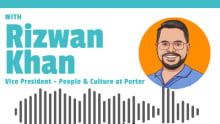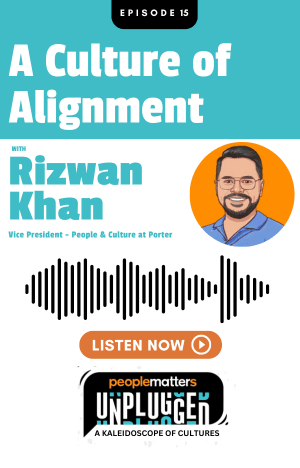Learning is a three-step cycle: practice, feedback and conceptual input, says enParadigm’s John Cherian

The skills landscape is undergoing tectonic shifts. Research reveals that globally, skills could change by 39% to 44% by 2025. This points out the challenging yet exciting time organizations today find themselves in. On the one hand, there are continuous disruptions and widening skill gaps brought on by new innovations in tech and economic uncertainty, but on the other hand, it is an opportunity to explore new ways of transformation and growth.
To stay ahead of the curve, leaders today are left with little choice but to break away from traditional models to remain agile and competitive. From addressing the needs of a diverse, remote workforce to bridging the skill gaps at speed, learning solutions and new-age paradigms will come to play a critical role. To unlock impactful insights on how to thrive in the era of work, worker and workplace transformation, we had an exciting conversation with John Cherian, Co-Founder, MD & CEO of enParadigm, one of the world's leading experiential learning and talent intelligence companies.
Of the many challenges that businesses need to urgently address, one of them is the Role-Fit-Crisis. Could you tell us more about it and its impact on the future of people and work?
Organisations today are not very cognizant of the role-fit challenge. In today’s business climate, where there’s over 20% attrition in every organisation, at the same time, almost 25% of employees are being marked as C-band or below (below expectations) in performance appraisal ratings. This means that you have 45% of people not delivering in their roles, which is almost one in two people. So when we need one person to perform their expected responsibilities, there’s always a backup person in the picture that businesses need to plan for, and this largely encapsulates what we call the ‘role-fit’ challenge.
There is a steady rise in the intersections between learning and technology today, which creates many opportunities to rise above challenges. What do you think will be the role played by innovations in the LearnTech space to solve this Role-Fit-Crisis?
Historically, learning solutions have been a one-size-fits-all type, where every professional tends to receive the same kind of input. But each role requires different skill sets or competencies for success, and every person who performs that role comes with a different proficiency level when it comes to those skills. So, the need of the hour is systems that can offer personalised learning based on the skill needs of the role and current capabilities of the professional. Learning solutions must be able to continuously deliver a delta increase in relevant skills for an employee over a period of time. enParadigm is committed to this endeavour, and our platform specialises in talent intelligence and experiential learning with the aim of helping organisations empower their employees in their roles.
With AI playing a critical role in the current business landscape, how is enParadigm skillfully leveraging AI to support the Talent and Business Community? Additionally, how are your competency assessments changing the way organizations conduct skill analysis and evaluate capability gaps?
AI has indeed made several leaps and bounds when it comes to solving various kinds of human problems, including personalization and immersive learning for each individual.
Today, we have access to big data across roles and industries, outlining skills and competencies for each role at a granular level. But it is nevertheless an ever-evolving landscape, with new skills in demand, and AI helps us with curating data about these ongoing shifts.
The other question that AI today is helping us answer is, ‘How do you make learning more immersive?’ From voice and emotion recognition to attention AI to even creating a 3D environment and lifelike characters, AI is making learning more interactive, closer to reality and immersive for the end-user.
At enParadigm, what we do through our competency assessments is look at the different roles people play and the particular skills needed. We then create scenarios for our participants to navigate, where they get immediate feedback regarding their proficiency levels based on their actions. Instead of just using psychometrics, we are moving towards a more direct way of evaluating how people will respond and react to different situations.
Enparadigm specialises in experiential learning solutions, with a suite of simulations centred around key business and behavioural competencies. Could you share with us how they have helped align learning outcomes and business impact? Any particular use case would you like to highlight?
The idea behind experiential learning is to give learners a very true-to-life environment. The challenge with learning solutions today is that they offer very passive learning experiences, where 90-95% of the time, you’re just consuming one-way information, which only results in some knowledge and awareness. Skills aren’t built; that happens when you get your hands dirty by tackling a real problem and getting real-world feedback on your approach. This leads to conceptual clarity over a period of time on how to get things done more systematically.
It’s a three-step cycle: practice, feedback and conceptual input. Most learning platforms offer theory, which learners quickly go through to finish the module. What we do is put people through these three steps over multiple cycles to build proficiency in that particular competency. And we have applied this framework across a range of role-specific skills as well as power (soft) skills, from interpersonal and leadership effectiveness to business and sales acumen and many more. We’ve created a huge library so that organisations have a wide variety of experiential learning pathways for their employees.
One example I can highlight is our partnership with a large bank, where 2500 branch managers went through an experiential learning environment to learn how to run a branch better, from maintaining business numbers, providing best-in-class customer experience and ensuring compliance and operational excellence parameters. For such a multi-functional role, we ran simulations to recreate the banking environment. Similarly, we also ran simulations for 5000 sales managers, helping them understand how to go through the sales cycle, win business, build more relationships with existing customers and upsell or cross-sell financial products to the right clients. So, we work with a lot of banks, as well as IT and consumer goods companies, offering them very industry-specific use cases.
As organisations today increasingly work with a hybrid, remote and distributed workforce, what are some best practices to ensure continuous, experiential and digital learning?
Today, the L&D programs of most organisations are point-in-time learning, where the process ends with a half-day or a two-day workshop. But skill builds up only when you’re continuously immersed in the learning environment, you get to try out different things and receive real-time feedback, resulting in incremental bits of clarity.
The challenge for organisations today is to find out solutions that can weave their way into a corporate worker’s busy work schedule. And that’s a problem we at enParadigm have solved by offering companies scenarios and simulations that are 10 to 30 minutes long at a time. That helps us fit into a busy work schedule, and the idea is to enable the learner to go through different skill paths over a period of time where they keep mastering different competencies on a continuous basis by spending at least an hour a week on capability building.
With ‘Lead Off: Built for Disruption’ being the central theme of our People Matters L&D Conference in Singapore, what are your thoughts on empowering a resilient workforce and building disruption-proof organisations?
Becoming disruption-proof really means, on the one hand, from a business perspective, working with different customers, geographies, and product lines so that if some of them get disrupted, you have the others running to maintain sustainability. From an L&D perspective, it’s really about building a broad variety of skills, so there is fungibility as professionals play different roles and the reliance on a few star individuals goes down.
And when it comes to employees especially, being skilled in several competencies ensures that if some skills become redundant due to disruption, other skills can be used for continued employability. Having a portfolio of skills indeed plays a critical role to counter disruption.
To get more exclusive insights from John Cherian, join us at People Matters L&D Singapore on 13 April at Fairmont, where he’ll be leading an exciting Masterclass on ‘Solving The Role-Fit Challenge For The Future Of Work’.














